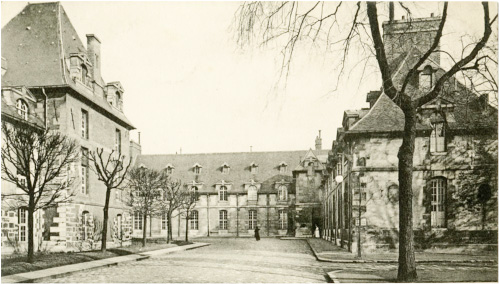A short history: first steps in nuclear medicine …
Everyone knows that the discovery of radioactivity and the isolation of radium were the joint work of Pierre and Marie Curie, assisted by Gustave Bémont, and led to decisive results in December 1898. Very quickly, the first biological tests of the new element thus isolated are attempted. In Germany, Giesel in 1899 and Walkhoff in 1900 attempted applications of radium on themselves and observed prolonged skin inflammation.
Pierre Curie then resumed these experiences, also on himself and involuntarily triggered the first known case of radio-dermatitis, which fortunately ended with recovery, but all the same after 6 weeks of bandages! Henri Becquerel in turn, after taking a glass tube containing a radium source in his waistcoat pocket, suffers from a festering sore which will take 2 months to disappear. He will say to the Curie couple, talking about radium: “I love it, but I blame it …

Radium rays on the skin ….
Photo of the “Pierre Curie” arm, burned by radium salt applied for 10 hours. This was also the time when people became aware of the effect of radiation and the possibility of using it for medical purposes. In 1900, the German dentist Walkhoff noted that radium rays act energetically on the skin in a manner analogous to that of X-rays. This observation was confirmed a few weeks later by the German chemist F. Giesel, with whom Pierre and Marie maintained regular correspondence.
© CNRS Audiovisuel
These first anecdotal essays were followed by increasingly thorough and serious studies which led in 1901 to a joint note by P. Curie and H. Becquerel on “The physiological action of radium rays”.
After the end of 1901, applications of radium took place in the Saint-Louis Hospital medical environment for therapeutic purposes. Doctor Danlos, using sources prepared by the Curie couple, made the first therapeutic tests on skin lesions. Pierre Curie, for his part, works with dermatologists on the action of radon on animals. Very quickly, a large number of studies on these subjects appeared in France and abroad.
During the following years, the medical applications of radium grew steadily, but it was by far cancer therapy that was the most fruitful. This was the beginning of “radium therapy” which quickly became “brachytherapy”. One realized that tumor cells, which multiply rapidly, were much more “radio-sensitive” than “normal” cells (Bergonié-Tribondeau law in 1906). Radium needles were then used to treat cancers of the uterus. These were the first brachytherapies.

1901 : beginnings of brachytherapy
At the Paris Saint-Louis hospital, Henri-Alexandre Danlos and Pierre Curie used radium for the treatment of lupus erythematosus and then skin cancer.
© Source : A.Aurengo
Claudius Regaud then developed needles containing radon and allowing selective treatment of deep tumors. Other teams developed a whole series of increasingly sophisticated irradiation techniques.
Marie Curie, alone after her husband death, then proposed the creation of the Institut du Radium, a “Radium Institute” whose principle was accepted in 1909. The buildings were completed in 1914 but the war delayed its inauguration.
It was also the time when a young Hungarian chemist, Georg de Hevesy, who came to work with Rutherford in Manchester, observed that he was unable to separate Radium-D, a radioactive derivative of radium from lead, since this derivative is actually a lead radioactive isotope. From this failure, he got the idea to use this radium-D to study the properties of lead. First applied to chemistry, this thecnique, the indicator method, was to be later extended to biology and medicine.
What then slows down the development of the indicator method is the small number of available natural radioelements! But in 1934, Irène and Frédéric Joliot-Curie demonstrated the possibility of creating radioactive isotopes of any element when, instead of having to be satisfied with the rare uranium and thorium descendants.
Y. Grall
Other articles on the subject « Discoveries »
Marie Curie
Marie Sklodowska-Curie had an exceptional destiny. Born in Poland, she came to graduate school in[...]
Three radiations
Understanding the nature of alpha, beta and gamma rays In the years following the discovery of ra[...]
Discovery of the Nucleus
A new vision of the atom In 1911, Rutherford, Marsden and Geiger discovered the dense atomic nucl[...]
Ernest Rutherford
In October 1895, landed in England a 24 years-old young New Zealander. His name was Ernest Ruther[...]
Rutherford’s experiment
The experiment which proved the existence of a nucleus in the atom In 1908, Ernest Rutherford rec[...]
The neutron : Chadwick
A close competition between great physicists … James Chadwick, who discovered the neutron i[...]
1934 : Artificial Radioactivity
The production at will of radioactive isotopes In the first days of 1934, Frederic and Irene Joli[...]
The Neutrino Hypothesis
The remarkable story of the neutrino The study of radioactive disintegrations had established tha[...]
Fission discovery
A nuclear phenomenon that escaped the hands of physicists In the years spanning 1934 to 1938, Enr[...]
Enrico Fermi
A genial experimenter and theoretician Enrico Fermi (Rome, September 29, 1901 – Chicago, No[...]